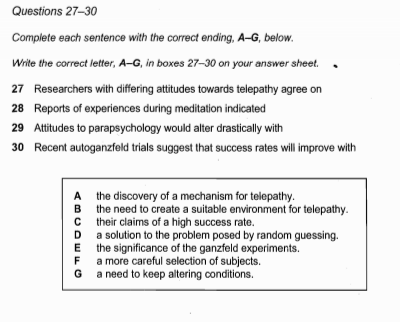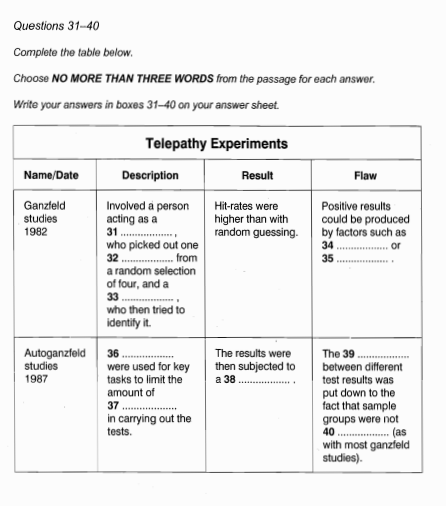剑桥雅思8阅读:Test1雅思阅读PASSAGE 3真题+答案+解析
发布时间:2020-11-23 关键词:今天新航道小编为各位雅思考生带来剑桥雅思8阅读解析Test1Passage3,希望可以帮助广大雅思考生轻松备考雅思。
READING PASSAGE 3
You should spend about 20 minutes on Questions 27 40, which are based on ReadingPassage 3 below.
TELEPATHY
Can human beings communicate by thought alone? For more than a
century the issue of telepathy has divided the scientific community, andeven today it still sparks bitter controversy among top academics
Since the 1970s, parapsychologists at leading universities and rese arch institutes aroundthe world have risked the derision of sceptical coileagues by putting the various claimsfor telepathy to the test in dozens of rigorous scientific studies. The results and theirimplications are dividing even the researchers who uncovered them.
Some researchers say the results constitute compelling evidence that telepathy is genuine.Other parapsychologists believe the field is on the brink of ollapse, having tried to
produce definitive scientific proof and failed. Sceptis and advocates alike do concur onone isue, however: that the most impresshve evidence s0 far has come from the so-called'ganzfeld' experiments, a German term that means whole field". Reports of telepathicexperiences had by people during meditation led parapsychologists to suspect thattelepathy might involve 'signals' passing between people that were so faint that theywere usually swamped by normal brain activity. In this case, such signals might be moreeasily detected by those experiencing meditation like tanuillitt in a relaxing 'wholefield" of light, sound and warmth.
The ganzfeld experiment tries to recreate these conditions with partkcipants sitting insoft reclining chairs in a sealed room, listening to relaxing sounds while their eyes arecovered with special filters ltting in only soft pink light. In early ganzfeld experiments,the telepathy test involved identification of a picture chosen from a random selectionof four taken from a large image bank. The idea was that a person acting as a 'sender'would attempt to beam the image over to the 'receiver' relaxing in the sealed room.Once the ssion was over, this person was asked to identify which of the four imageshad been used. Random guessing would give a hit-rate of 25 per cent; if telepathy is real,however, the hit-rate would be higher. in 1982, the results from the first ganzfeld studieswere analysed by one of its pioneers, the American parapsychologist Charles Honorton.They pointed to typical hit rates of better than 30 per cent - a small effect, but one whichstatistical tests suggested could not be put down to chance.
The impliation was that the ganzfeld method had revealed real evidence for telepathy.But there was a crucial flaw in this argument - one routinely overlooked in more conventionai areas of science. Just because chance had been ruled out as an explanationdid not prove telepathy must exist; there were many other ways of getting positive results. These ranged from 'sensory leakage' - where dues about the pictures acodentallyreach the receiver - to outright fraud. In response, the researchers ssued a review of allthe ganzfeld studies done up to 1985 to show that 80 per cent had found tatsicalysignificant evidence. However, they alo agreed that there were still too many problemsin the experiments which could lead to positive results, and they drew up a list demandingnew standards for future research.
After this, many researchers switched to autoganzfeld tests - an automated variant of thetechnique which used computers to perform many of the key tasks such as the randomselection of images. By minimising human involvement, the idea was to minimise the riskof flawed results. In 1987, results from hundred of autoganzfeld tests were studied byHonorton in a 'meta-analysis, a satistial technique for finding the overal results from aset of studies. Though less compelling than before, the outcome was still impressive.
Yet some parapsychologists remain disturbed by the lack of consistency between
individual ganzfeld studies, Defenders of telepathy point out that demanding impressiveevidence from every study ignoresọne basic statistical fact: it takes large samples to
detect small effects. lf, as current results suggest, telepathy produces hit-rates onlymarginally above the 25 per cent expected by chance, it's unlikely to be detected byatypical ganzfeld study involving around 40 people: the group is just not big enough. Onlywhen many studies are combined in a meta analysis will the faint signal of telepathy
really become apparent. And that is what researchers do seem to be finding
What they are certainly not finding. however, is any change in atitude of mainstreamscientists. most still totally reject the very idea of telepathy. The problem stems at least inpart from the lack of any plausible mechanism for telepathy.
Various theories have been put forward, many focusing on esoteric ideas from theoreticalphysics. They include 'quantum entanglement', in which events affecting one group
of atoms instantly affect another group, no matter how far apart they may be. Whilephysicists have demonstrated entanglement with specially prepared atoms, no-one
knows if it also exists between atoms making up human minds. Answering such questionswould transform parapsychology. This has prompted some researchers to argue that
the future lies not in olleting more evidence for telepathy, but in probing possiblemechanisms. Some work has begun already, with researdhers trying to identify peoplewho are particularly uccessful in autoganzfeld trials. Early results show that creative andartistic people do much better than average: in one study at the University of Edinburgh,musicians achieved a hit-rate of 56 per cent. Perhaps more tests like these will eventuallygive the researchers the evidence they are seeking and strengthen the case for the existence of telepathy.
剑桥雅思8阅读Test1Passage3原文翻译-心灵感应
人类可否只通过思想进行沟通交流? 一百多年来,关于心灵感应的话题在科学界产生很大意见分歧,时至今日,它依然在学界精英中引起激烈辩论。
自上个世纪70年代以来,在世界各大高校和科研院所,超心理学者们冒着被同行嘲笑和 怀疑的风险,将关于心灵感应的各种不同说法进行严格的科学实验,其结果及其启示即使在研究者本身中,也引发了很大争议。
有些科学家认为,实验结果提供了强有力证据,可以证明心灵感应是真实存在的。另一些超心理学家则相信,该研究虽试图用科学证据证明心灵感应存在,却并未取得成功,相关研究也都处在失败的边缘。不过无论是怀疑者还是倡导者都同意一点,即迄今最有力的证据来自于“ganzfeld”实验。该实验名称来自德语,意思是“全域”。通过冥想心灵感应实验者的报告,超心理学家怀疑,可能因为人们之间传递的“信号”过于模糊,以至于很容易被正常的脑波活动所覆盖。如果这样的话,当人们身处一个伴有灯光和音响的温暖轻松的环境,经历冥想般的宁静,会更容易感知此类信号。
该实验几乎满足了所有的条件。参加者待在密封的房间里,坐着柔软的躺椅,听着轻松的音乐,眼睛被特殊的过滤器覆盖,只看见柔和的粉色光。早期的实验主要涉及选图。先从一个大型图库中任意选出四张图片,再让实验者指认其中一张。具体操作步骤是,作为“发送人”的实验者努力将一张图通过思维传给密封房间内的“接收人”。当传送结束后,“接收人”需从四张图中选出哪一张才是刚刚被传送的图。如果是随便猜测,可达到25%的命中率。然而,如果心灵感应真的存在,命中率就应该更高。1982年,心灵感应研究的先行者之一,美国超 心理学家查尔斯·荷诺顿(Charles Honorton)分析了这些早期实验的结果。结果证明典型的命中率要高于30%。虽然比例高不了多少,但统计测试表明,结果已不完全是偶发几率。
“ganzfeld”实验似乎可以证明心灵感应是真的存在。但是在这个论据本身有个不足之处,在传统科学领域中也常常被忽视:不能因为排除了偶然几率的存在,就能证明心灵感应就是真实存在的。其他方法也可以得出正向的结果:既有图片线索偶然传递给接受者的感官泄露,也有彻底的欺骗。作为回应,研究人员回顾了截至1985年的全部ganzfeld 研究,结果显示80%的研究提供了重要的统计数据。不过,他们也同意,实验中太多的因素都可导致正向结果,因此他们制定了清单,希望在未来研究中可采用新的标准。
此后,许多研究人员转向autoganzfeld 测试。这种自动化技术使用电脑来完成关键任务如随机选择图像。通过限度地减少人为参与,尽量降低错误结果出现的风险。1987年,荷诺顿(Honorton)使用了“荟萃分析”,这是一种可以从系列研究中找出整体结果的新型统计方法。他对数以百计的 autoganzfeld 实验结果进行了分析,虽然没有以前那样引人注目,结果依然令人印象深刻。
然而,单独的ganzfeld 实验研究彼此间缺乏一致性,这让一些超心理学家感到十分困扰。心灵感应拥护者们指出,如果要求每一项研究都得出满意结果,起码忽略了一个基本的统计学事实:需要大量的样本才能得出少量的结果。如果像目前的结果显示那样,偶然几率是 25%,而心灵感应存在的几率只略高于它,真正的证据就不可能由一个典型的约40人参加的ganzfeld 实验所提供:因为样本集合不够大,数目不够多。只有用“荟萃分析”将多项实验研究结合起来,心灵感应存在的证据才会由模糊变得清晰。而这貌似也是研究者们所正在追寻的。
主流科学家们对于心灵感应的态度仍未变化:大部分仍完全拒绝承认心灵感应的存在。部分原因在于,心灵感应缺乏真实可靠的原理。
各种各样的理论纷纷出现,绝大多数以理论物理学的深奥理论为中心。它们包括“量子纠 缠”,即影响一组原子的事件立刻影响另一组,无论它们彼此之间距离有多远。虽然物理学家 利用精心准备的原子证实了“量子纠缠”的存在,却没人知道它们是否也会存在于组成人体的原子之间。这个问题的肯定回答将会改变超心理学。受此启发,一些研究人员认为,超心理学 的未来不在于收集的证据证明心理感应存在,而在于寻求其可能的原理。此类工作目前已经展开。研究人员试图确定在autoganzfeld实验中成功率较高的目标人群。早期结果证明,从事创造性和艺术性工作的人,在实验中的命中率要高于普通人。在爱丁堡大学开展的一项研究中,音乐家的命中率达到了 56%。也许当此类实验出现,它们终将为研究者提供证据,并为心灵感应的真正存在增强说服力。


体裁:说明讨论为主
主要内容:本文主要介绍关于心灵感应的研究。
结构:
第 1 段 :学者针对心灵感应进行科学试验。
第 2 段 :不同意见都认为 ganzfeld 实验可提供证据。
第 3 段 :详细介绍 ganzfeld 实验。
第 4 段 :ganzfeld 实验仍不能真正证明心灵感应的存在。
第 5 段 :介绍另一种实验——应用高科技的 autoganzfeld 实验。
第 6 段 :autoganzfeld 实验也有其不足之处。
第 7 段 :主流学术界对于心灵感应的态度。
第 8 段 :研究者不再致力搜寻证据,转而寻求心灵感应的原理。
师资点题剑桥雅思8阅读:
Questions 27-30
● 题型归类 :Matching 本题按文章顺序出题。 27 researchers, differing attitudes, agree on 第二段第 3句 答案 E 通过题目中定位词找到文章中的具体表 达 :第二段第 3 句。题目中的 differing attitudes 对应文章中的 skeptics and advocates,题目中 的 agree on 对应文章中的 do concur on。由本 句名词性从句的主干 evidence...come from... experiments 即可得出答案。所有选项中提到 experiment 的只有一个。
28 meditation 第二段倒 数第 1 句 答案 B 通过题目中定位词 meditation 找到文章 中第二段倒数第 5 行。题目中要求找到实验的 启示,答案出现在下一句中,其中 in a relaxing ‘whole field’of light, sound and warmth 是题目中 的 suitable environment 的具体表现。
29 attitudes, alter drastically 倒数第二 段 答案 A 通过题目中定位词 attitude 和 alter 找到 文章中倒数第二段第 1 句 change in attitude。第 1 句中说主流科学家不改变态度,第 2 句中则说, 其中原因在于 lack of...mechanism。
30 recent autoganzfeld trails, success rates 最后一段 倒数第 2-3 句 答案 F 通过题目中定位词 success rates 找到文章 中最后一段倒数第 5 行。文章中提到 creative and artistic people 表现尤为出色,故成功率与实验对 象相关。
剑8Test3解析查看,请点击;
剑桥雅思8口语Test3Part2范文:meeting话题
剑桥雅思8听力Test3Section1原文+答案解析
剑8听力Test3Section3原文+答案解析
师资点题剑桥雅思8阅读:
Questions 31-40
● 题型归类:Table 解答表格题目时,如题目表格中所给字数较多,可先用半分钟的时间仔细观察表格,待清楚表格大致内容及所需信息后,再行解题。以本表格为例,按照一般表格制表规律,先从左向右,再从上向下,表格各列分别标明实验时间、实验过程、实验结果、及实验不足之处。分为两行,则表明表格由两个不同时间的实验构成。
35or第四段第6行由题目中or一词可知本题与上题是并列 关系,确定了上一题的答案后,再通过文章中的from sensory leakage ... to outright fraud便可以很容易地确定答案。本题答案为outright fraud。
361987,key tasks第五段第2行由题目中的1987迅速定位至文章第5段,再由题目中的key tasks定位至该段第 2 行。根据which used computers to perform many of the key tasks such as... 可以确定本题答案为computers。 37limit 第五段第3行由题目中limit 定位至文章中第五段第3行minimising。 因该句中出现两minimising,由空格后面的定语in carrying out the tests可排除掉后面的 the risk of flawed results,也可通过题目要求NO MORE THAN THREE WORDS进行排除。本题答案为human involvement。38results, subjected to a 第五段倒数第2行由冠词a可知,本题需要填入一个单数可数名词。沿上道题答案继续向后在第4行找到 results。 通过文中的In 1987,results...were studied by Honorton in a‘meta-analysis’可以确定本题答案为meta-analysis。39flaw, different test results 第六段第1行由flaw一词定位至第六段第1句。段首的强转折词yet表明本段与上文所表达意思相对或相反。题目中的between different test results对应文章中的between individual ganzfeld studies,从而可以确定本题答案为lack of consistency。40fact,sample group,not 第六段第3行或倒数第3行本题需填入形容词。通过题目中的sample groups were not直接找逻辑关系即可在第6段倒数第3行中的the group is just not big enough找到答案big enough;或在本段第3行找到 fact,根据句子it takes large samples to detect small effects确定本题还可以填 large enough。所以本题答案为big/large enough。
题目编号 题目定位词 答案位置 题解
31 1982,four 第三段第 5 行 由空格前冠词和空格后的定语从句引导词 who 可知本题需填入一个指代人的单数可数 名词。通过题目中数字 1982 迅速定位至文章第三 段。再通过数字 four 定位至该段第 5 行。本 题答案为 sender。
32 one, four 第三段第 6 行 本题需填入一个单数可数名词。本题答案同 上题答案出现在同一句中。由题目中逻辑关 系 one...of four 即可得出答案。本题答案为 image/picture。
33 identify 第三段第 6 行 本题需填入一个指代人的单数可数名词,由 其动词 identify 找到主语即可。本题答案为 receiver。
34 flaw, positive results 第四段第 5 行 由题目中 flaw 一词定位至第四段第 2 行,由 positive results 进一步定位至第四段第 4-5 行。 由题目中 such as 可知本题需填入具体例子, 所以本题答案为 sensory leakage。
师资点题剑桥雅思8阅读:
参考译文
心灵感应
人类可否只通过思想进行沟通交流? 一百多年来,关于心灵感应的话题在科学界产生很大意见分歧,时至今日,它依然在学界精英中引起激烈辩论。
自上个世纪70年代以来,在世界各大高校和科研院所,超心理学者们冒着被同行嘲笑和 怀疑的风险,将关于心灵感应的各种不同说法进行严格的科学实验,其结果及其启示即使在研究者本身中,也引发了很大争议。
有些科学家认为,实验结果提供了强有力证据,可以证明心灵感应是真实存在的。另一些超心理学家则相信,该研究虽试图用科学证据证明心灵感应存在,却并未取得成功,相关研究也都处在失败的边缘。不过无论是怀疑者还是倡导者都同意一点,即迄今最有力的证据来自于“ganzfeld”实验。该实验名称来自德语,意思是“全域”。通过冥想心灵感应实验者的报告,超心理学家怀疑,可能因为人们之间传递的“信号”过于模糊,以至于很容易被正常的脑波活动所覆盖。如果这样的话,当人们身处一个伴有灯光和音响的温暖轻松的环境,经历冥想般的宁静,会更容易感知此类信号。
该实验几乎满足了所有的条件。参加者待在密封的房间里,坐着柔软的躺椅,听着轻松的音乐,眼睛被特殊的过滤器覆盖,只看见柔和的粉色光。早期的实验主要涉及选图。先从一个大型图库中任意选出四张图片,再让实验者指认其中一张。具体操作步骤是,作为“发送人”的实验者努力将一张图通过思维传给密封房间内的“接收人”。当传送结束后,“接收人”需从四张图中选出哪一张才是刚刚被传送的图。如果是随便猜测,可达到25%的命中率。然而,如果心灵感应真的存在,命中率就应该更高。1982年,心灵感应研究的先行者之一,美国超 心理学家查尔斯·荷诺顿(Charles Honorton)分析了这些早期实验的结果。结果证明典型的命中率要高于30%。虽然比例高不了多少,但统计测试表明,结果已不完全是偶发几率。
“ganzfeld”实验似乎可以证明心灵感应是真的存在。但是在这个论据本身有个不足之处,在传统科学领域中也常常被忽视:不能因为排除了偶然几率的存在,就能证明心灵感应就是真实存在的。其他方法也可以得出正向的结果:既有图片线索偶然传递给接受者的感官泄露,也有彻底的欺骗。作为回应,研究人员回顾了截至1985年的全部ganzfeld 研究,结果显示80%的研究提供了重要的统计数据。不过,他们也同意,实验中太多的因素都可导致正向结果,因此他们制定了清单,希望在未来研究中可采用新的标准。
此后,许多研究人员转向autoganzfeld 测试。这种自动化技术使用电脑来完成关键任务如随机选择图像。通过限度地减少人为参与,尽量降低错误结果出现的风险。1987年,荷诺顿(Honorton)使用了“荟萃分析”,这是一种可以从系列研究中找出整体结果的新型统计方法。他对数以百计的 autoganzfeld 实验结果进行了分析,虽然没有以前那样引人注目,结果依然令人印象深刻。
然而,单独的ganzfeld 实验研究彼此间缺乏一致性,这让一些超心理学家感到十分困扰。心灵感应拥护者们指出,如果要求每一项研究都得出满意结果,起码忽略了一个基本的统计学事实:需要大量的样本才能得出少量的结果。如果像目前的结果显示那样,偶然几率是 25%,而心灵感应存在的几率只略高于它,真正的证据就不可能由一个典型的约40人参加的ganzfeld 实验所提供:因为样本集合不够大,数目不够多。只有用“荟萃分析”将多项实验研究结合起来,心灵感应存在的证据才会由模糊变得清晰。而这貌似也是研究者们所正在追寻的。
主流科学家们对于心灵感应的态度仍未变化:大部分仍完全拒绝承认心灵感应的存在。部分原因在于,心灵感应缺乏真实可靠的原理。
各种各样的理论纷纷出现,绝大多数以理论物理学的深奥理论为中心。它们包括“量子纠 缠”,即影响一组原子的事件立刻影响另一组,无论它们彼此之间距离有多远。虽然物理学家 利用精心准备的原子证实了“量子纠缠”的存在,却没人知道它们是否也会存在于组成人体的原子之间。这个问题的肯定回答将会改变超心理学。受此启发,一些研究人员认为,超心理学 的未来不在于收集的证据证明心理感应存在,而在于寻求其可能的原理。此类工作目前已经展开。研究人员试图确定在autoganzfeld实验中成功率较高的目标人群。早期结果证明,从事创造性和艺术性工作的人,在实验中的命中率要高于普通人。在爱丁堡大学开展的一项研究中,音乐家的命中率达到了 56%。也许当此类实验出现,它们终将为研究者提供证据,并为心灵感应的真正存在增强说服力。




